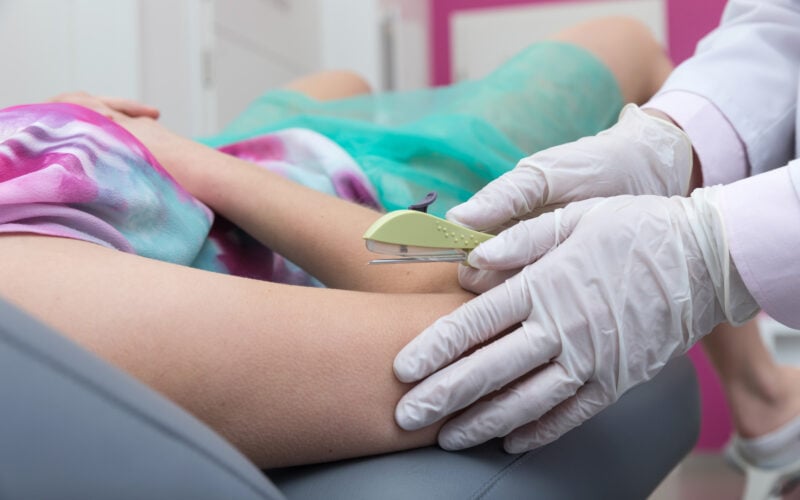The final line of the worldwide hit The Barbie Movie is Barbie exclaiming “I’m here to see my gynecologist!” A trip to her OB/GYN is her first big task after (spoiler alert!) leaving her life in Barbieland behind to embrace the real world as an adult woman. Was this the writers’ humorous clarification that Barbie was definitely a human, and no longer a toy? While I can’t be sure what the intention was behind this line, to me, it sounded like the message sent to many teens by the culture, and even by their parents and doctors: contraception is a key step to becoming a woman. And increasingly, teens are using LARCs, long-acting reversible contraceptives.
What are LARCs?
LARCs include intrauterine devices (IUDs) and the arm implant. Examples include Paragard, a copper IUD that lasts up to ten years; hormonal IUDs that work by releasing progestin for 3-7 years; and Nexplanon, which is inserted into the arm and releases progestin for up to 3 years. Unlike the Pill, which needs to be taken by the patient at the same time each day, LARCs require no action by the patient after their insertion. This is why they are often billed as “set it and forget it” forms of birth control.
Why are long-acting reversible contraceptives encouraged for teens?
While rates of teen sexual activity and teen pregnancy greatly declined over the past three decades, the CDC still reports the US teen pregnancy rate to be higher than in other industrialized nations. Some health care providers believe they have a moral duty to make sure their teen patients are on contraception to further curb rates of unintended pregnancy. Under this goal of pregnancy prevention, LARCs hold great appeal for doctors who serve teens.
Reasons doctors encourage LARCs for teens
For one, the American College of Obstetricians and Gynecologists (ACOG) lauds the high efficacy and continuation rates that LARCs offer [4]. Another benefit is that LARCs are not subject to user error since they are inserted or implanted in the body by a medical professional (this does not mean there cannot be insertion error, though). Nor are LARC users subject to missed doses, improper storage (too hot, cold or humid), or poor absorption due to digestive problems.
LARCs also last a long time. Even at the lower end of the range, a contraceptive effect for three years would carry a senior in high school well into young adulthood, when pregnancy is much more common than in adolescence.
Why some parents want their teens to use LARCs
But it’s not just physicians. Many parents also want their teens to use IUDs. When I taught sex education to high school students, the teens invariably told me that their parents had told them nothing about sex or even dating in general. For too many parents, the idea of their children someday having sex is awkward, uncomfortable, or may bring up memories of their own past mistakes or painful experiences. It can be tempting for parents to look to LARCs as a way to prevent their teen from becoming pregnant without needing to have any difficult or uncomfortable conversations with them about sex.
What are the risks of LARC use in teens especially?
A quick internet search into “are IUDs safe?” will be answered with a resounding “yes!” However, while major medical organizations are quick to sidestep concerns, individuals who have been harmed by LARCs strive to raise awareness about dangerous potential side effects such as severe anxiety, depression, symptoms of copper toxicity (specific to the copper IUD), and implant migration (which can happen with both IUDs and the Nexplanon). Besides these side effects, the pregnancy prevention rate of LARCs may not be as high as many companies claim.
Additional concerns with teen LARC use include:
- Delayed treatment of reproductive issues. Birth control is a common treatment for irregular cycles, period pain, and conditions like PCOS and endometriosis. However, while contraception may do a good job at managing some teens’ symptoms, LARCs cannot cure disease or restore health. Delaying proper treatment can make conditions more difficult to treat after discontinuing contraceptive use, and as this case study demonstrates, even raise the question of a connection between IUD use and endometriosis development [1].
- Potential added pressure to have sex. One thing sex education models tend to agree on is that sexual behavior can have profound consequences. In a sexual risk reduction model, the emphasis is placed on merely reducing the physical consequences of sex, especially through promoting effective contraception like LARCs. But this can sometimes leave teens with the impression that sexual activity is expected of them, and that delaying sex until later is socially abnormal. How many teens want to be perceived as abnormal by their peers? Conversely, sexual risk avoidance programs tend to focus on the whole-person effects of sexual activity and support teens in delaying sexual activity.
- Increased STI risk. According to the CDC, half of all STD infections in the U.S. occur in people who are between the ages of 15 and 24 [6]. Young women are more likely to contract an STD than adult women because they produce less cervical mucus and have a larger transformation zone on their cervixes, so the cervix is more vulnerable to infection [2]. IUDs and implants do not protect against STDs and may contribute to teens feeling more lax about risky sexual behavior.
Why is fertility awareness a better alternative?
Teaching fertility awareness methods (FAM) to teens goes far beyond the goal of pregnancy avoidance. Teaching a young woman about how her body works truly supports her empowerment. Practically speaking, learning to track her fertility will serve her well in predicting periods, identifying hormonal or reproductive disorders, and avoiding or achieving pregnancy when it becomes appropriate (and when natural family planning method rules can be learned and layered on top of her existing fertility awareness knowledge).
Less tangible are the executive skills FAM gives teens the opportunities to cultivate, like self-awareness, self-discipline, self-advocacy, organization, and communication. For parents who may be concerned that fertility awareness wouldn’t be enough to protect a potentially sexually active teen from pregnancy, research conducted by TeenSTAR found that 97-99% of program participants kept their virginity and 40-50% of previously sexually active teen boys ceased sexual activity [3]. Learning to understand and respect the human body can have a profound impact for teens of both sexes.
Teaching teens about fertility awareness is certainly more work than scheduling an OB/GYN appointment to get an IUD or implant. In our experience, though, teens are up for the challenge and open to the closer relationship with their moms that naturally develops when they learn more about their bodies and fertility. Teaching teens FAM teaches them that their menstrual cycle is something good, normal, and healthy, and helps them to achieve their goals without the risk of any dangerous side effects–something LARCs simply can’t offer.
References:
[1] Guaschino, S et al. “Sulla possibilità di correlazione tra IUD ed endometriosi” [On the possibility of correlation between an IUD and endometriosis]. Minerva ginecologica vol. 33,2-3 (1981): 279-82. [2] Shannon CL, Klausner JD. The growing epidemic of sexually transmitted infections in adolescents: a neglected population. Curr Opin Pediatr. 2018 Feb;30(1):137-143. doi: 10.1097/MOP.0000000000000578. PMID: 29315111; PMCID: PMC5856484. [3] Cabezón, Carlos et al. “Adolescent pregnancy prevention: An abstinence-centered randomized controlled intervention in a Chilean public high school.” The Journal of adolescent health : official publication of the Society for Adolescent Medicine vol. 36,1 (2005): 64-9. doi:10.1016/j.jadohealth.2003.10.011Additional Reading:
Who gets to decide whether teen girls use birth control, parents or their daughters?
Teens and sex: Why sexually transmitted infections wreak greater havoc on teens than adults







